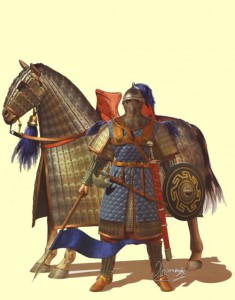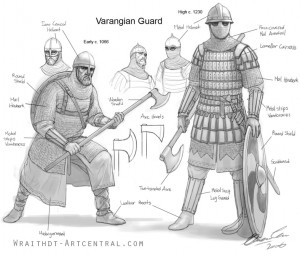 The backbone of the Byzantine army when it dominated the Mediterranean was the feared cataphract. But what exactly- as Joseph asks- was a cataphract? The short answer is the Byzantine version of the knight on horseback. The Roman term was clibanarii which somewhat hilariously translates as ‘furnace’- probably an apt description of what it felt like to wear the armor on a sunny day.
The backbone of the Byzantine army when it dominated the Mediterranean was the feared cataphract. But what exactly- as Joseph asks- was a cataphract? The short answer is the Byzantine version of the knight on horseback. The Roman term was clibanarii which somewhat hilariously translates as ‘furnace’- probably an apt description of what it felt like to wear the armor on a sunny day.
There were three protective layers to bake in. The first (peristhethidion) was a padded leather jacket with short sleeves (a pair of greaves covered the arms) and a padded skirt faced with mail or scales to protect the legs. Over that was the klivanion, a mailed covering of the chest and shoulders, complete with a metal helmet hung with mail to cover the face (excepting the eyes). The final layer was the epilorikion, a padded cotton or thickly-stitched silk surcoat which would identify rank or unit. The poor horse- who had to carry this weight- was also covered with an iron headpiece and a thick ox-hide or laminated felt draping.
The cataphract carried a small round shield and a relatively short spear (roughly 8 feet long). In addition to this they carried two swords- one slightly curved, the other straight and double-sided. Some also carried a short bow or various kinds of maces and axes.
For the Roman empire they were never more than a small, peripheral force. The late 4th century document Notitia Dignitatum which records the administrative organization of the imperial armies mentions that there were 9 units of heavily armored knights, which means that they made up roughly 15% of the field army.
They seem to have gradually faded from use (completely vanishing by the 7th century) until their sudden emergence as the preferred troops of the terrifying emperor Nicephorus Phocas. In fact, most of what we know about them comes from the military manual that the emperor himself wrote (Praecepta Militaria) around the year 965 AD. But their renaissance proved short. Nicephorus’ (eventual) successor Basil the Bulgar-Slayer seems not to have used them, largely replacing them with his newly created Varangian Guard. After the military disaster of Manzikert in 1071, the imperial armies were largely mercenary and far less formidable. With the brief exception of the army of Manuel Comnenus, the empire never fielded a significant land force again.
 Listener William asked who the Varangians were and why they figured so prominently in Byzantine military affairs.
Listener William asked who the Varangians were and why they figured so prominently in Byzantine military affairs.
The Varangians were the elite forces of the Byzantine army- much like the Praetorian Guard of ancient Rome or the Ottoman Janissaries. They were originally made up exclusively of Vikings (which the empire had been hiring as mercenaries since the 9th century), but after the Norman Conquest of England a rush of exiled Anglo-Saxons were added to the mix. By the 12th century there were so many English that it was commonly being referred to as the ‘Anglo-Varangian’ Guard. As the empire declined, the Varangians also fell on hard times. By the middle of the 14th century they had largely ceased to function and the last mention of them is in the first decade of the 15th century.
They appeared relatively late in Byzantine history. In 988, the emperor Basil II, facing a serious revolt, asked the Viking prince of Kiev for some help. In exchange for an imperial bride, the prince sent along 6,000 warriors and Basil was so pleased by their effectiveness that he made them his permanent bodyguard. Their oaths were to him personally- a fact that the court was uncomfortably aware of- and they were housed in the Bucoleon Palace where they could keep an eye on things. Basil made sure they were given a generous salary and he called them ‘Varangians’- literally ‘men of the pledge’.
Since they were professional fighters they were the most valuable troops in an army made up mostly of mercenaries or levies. Usually taller and fiercer than their Mediterranean hosts/opponents, they also made good use as propaganda tools to overawe rebellious subjects or frighten opposing armies. In times of peace they could act as a police force in Constantinople or for ceremonial functions. In war they were usually held in reserve until the critical phase of the battle- then sent where the fighting was thickest. Even the Byzantines seem to have been slightly terrified of their berserker rages.
The opportunities for wealth ensured a steady stream of recruits, and few returned home empty-handed. At the death of an emperor they had the curious right to raid the treasury and take away whatever they could carry unassisted. Perhaps because of this they gained a reputation for fierce loyalty to the office- but not necessarily the occupant- of the throne.
At times the temptations of power were too much to resist and they would lord it over the population of Constantinople- usually in the local wine shops. Their drinking bouts were almost as legendary as their fighting skills and a visiting Danish king in the 11th century was embarrassed enough to publicly lecture them about their behavior.
His words do not appear to have had the desired effect. A century later some brave soul referred to the Varangians as the ‘Emperor’s wine-bags’.
 The backbone of the Byzantine army when it dominated the Mediterranean was the feared cataphract. But what exactly- as Joseph asks- was a cataphract? The short answer is the Byzantine version of the knight on horseback. The Roman term was clibanarii which somewhat hilariously translates as ‘furnace’- probably an apt description of what it felt like to wear the armor on a sunny day.
The backbone of the Byzantine army when it dominated the Mediterranean was the feared cataphract. But what exactly- as Joseph asks- was a cataphract? The short answer is the Byzantine version of the knight on horseback. The Roman term was clibanarii which somewhat hilariously translates as ‘furnace’- probably an apt description of what it felt like to wear the armor on a sunny day.